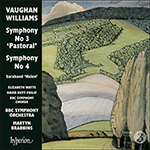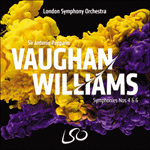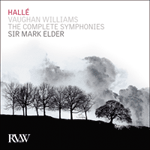
Welcome to Hyperion Records, a British classical label devoted to presenting high-quality recordings of music of all styles and from all periods from the twelfth century to the twenty-first.
Hyperion offers both CDs, and downloads in a number of formats. The site is also available in several languages.
Please use the dropdown buttons to set your preferred options, or use the checkbox to accept the defaults.

As with the composer’s programme note for the first performance of the ‘Pastoral’, that which he provided for the premiere of the F minor symphony is concerned entirely with musical matters, but once again it is the composer’s widow who explains the everyday moment of creative impulse. It appears he had read a fictional ‘Freak Festival’ account: ‘In which a symphony … was described in some detail … his breakfast-time reaction was an immediate ‘il faut je compose cela’. So, without any philosophical, prophetic or political germ, No 4 took its life from a paragraph in The Times.’
Whatever mundane circumstance was the initial spur to begin the symphony, the result after three years’ work was music of genius. Such is the symphony’s immediate impact that we may well imagine its ferocious expression to have been welling up in the composer’s creative subconscious, awaiting that spur.
The symphony is dedicated to Sir Arnold Bax. In 1922, Bax had dedicated his Lyrical Interlude for string quintet, and later his String Quartet No 2 of 1925, to Vaughan Williams. It may be that Vaughan Williams’s inscription of his F minor symphony to Bax was in return for those dedications.
The symphony opens with a grinding semitonal fortissimo clash, from which emerge two principal themes that are to run through the entire work. Virtually throughout they are treated to the composer’s complete mastery of contrapuntal devices, and are always aligned to their emotional and expressive nature as the inherently compact structures unfold. If the overriding impression given by this symphony is one of ferocious concentration, leavened at various points by elements of relaxation (in particular, the pianissimo coda to the first movement, wherein the ‘triplanar harmony’ of the ‘Pastoral’ is put to quite different expressive use by way of a soft major key reminiscent of an earlier intense cantilena), the attentive listener is gripped by the range, power and expressive immediacy of the music, from the all-pervasive four-note figure that inhabits much of the work to the intensity of the composer’s inspiration and seemingly limitless variation of that figure. From the four nobly rising chords that open the second movement to the solo flute cadenza that heralds its conclusion, this unfolding andante moderato offers no escape from serious matters, leading by way of that cadenza to the scherzo whose trio section (in strict classical terms) is a fugato on elements from both preceding movements.
As the composer wrote: ‘After a recapitulation of the Scherzo a long crescendo on a pedal leads direct to the Finale. This opens with a more energetic version of the cadence figure from the second movement.’ Here Vaughan Williams has utilized the same joining-of-movements device found in Beethoven’s fifth symphony—but this is no slavish imitation: it is wholly organic to Vaughan Williams’s quite different expressive purposes, as the symphony struggles to free itself from the obsessions that have constantly threatened it. Even in the epilogue, ‘an extraordinarily powerful use of fugal devices’ (as Edmund Rubbra described it), there is no way out: as the symphony races to its closing pages, the very opening of the work returns, shutting the door on any attempt to escape and thus binding together the symphony as a whole.
from notes by Robert Matthew-Walker © 2020
Comme le programme que rédigea le compositeur pour la première exécution de la «Pastoral» Symphony, celui qu’il écrivit pour la création de la Symphonie en fa mineur traite uniquement de questions musicales mais, une fois encore, c’est la veuve du compositeur qui explique quel fut le moment déterminant d’impulsion créative. Il semble qu’il avait lu un compte-rendu fictif du «Freak Festival»: «Dans lequel une symphonie … était décrite en détail … sa réaction au petit-déjeuner fut immédiate “il faut je compose cela”. Donc, sans le moindre germe philosophique, prophétique ou politique, la no 4 tira sa vie d’un paragraphe du Times.»
Quelles que soient les circonstances initiales qui l’incitèrent à commencer cette symphonie, le résultat après trois ans de travail, fut une musique de génie. L’impact immédiat de la symphonie est tel qu’on peut très bien imaginer son expression féroce qui prit forme dans le subconscient créateur du compositeur, attendant cet aiguillon.
Cette symphonie est dédiée à Sir Arnold Bax. En 1922, Bax avait dédié son Lyrical Interlude pour quintette à cordes à Vaughan Williams, et plus tard son Quatuor à cordes n° 2 en 1925. Il se pourrait que Vaughan Williams ait dédié à Bax sa Symphonie en fa mineur en retour de ces dédicaces.
La symphonie commence par un choc fortissimo semitonal grinçant, d’où émergent deux thèmes principaux qui se retrouvent dans toute l’œuvre. Ils sont traités quasiment du début à la fin avec la maîtrise totale des procédés contrapuntiques du compositeur et s’alignent toujours sur leur nature émotionnelle et expressive au fur et à mesure que se déroulent les structures intrinsèquement compactes. Si l’impression première que donne cette symphonie est une impression de concentration acharnée, tempérée en divers endroits par des éléments de détente (en particulier, la coda fortissimo du premier mouvement, où l’«harmonie triplanaire» de la «Pastoral» Symphony est ici utilisée à des fins expressives très différentes par le biais d’une tonalité majeure douce évoquant une cantilène antérieure d’une grande intensité), l’auditeur attentif est saisi par la portée, la puissance et l’immédiateté expressive de la musique, depuis la figure omniprésente de quatre notes qui habite une grande partie de l’œuvre jusqu’à l’intensité de l’inspiration du compositeur et aux variantes apparemment illimitées de cette figure. Des quatre accords majestueusement ascendants qui ouvrent le deuxième mouvement à la cadence de la flûte solo qui annonce sa conclusion, cet andante moderato en évolution constante ne permet pas d’échapper aux choses sérieuses, menant par le biais de cette cadence au scherzo dont le trio (en termes classiques stricts) est un fugato sur des éléments des deux mouvements précédents.
Comme l’a écrit le compositeur: «Après une réexposition du Scherzo, un long crescendo sur une pédale mène directement au Finale. Celui-ci commence par une version plus énergique de la figure de cadence du deuxième mouvement.» Ici, Vaughan Williams a utilisé le même procédé de rapprochement des mouvements que Beethoven dans la cinquième symphonie—mais il ne s’agit pas d’une imitation servile: c’est totalement intrinsèque aux objectifs expressifs très différents de Vaughan Williams, puisque cette symphonie s’efforce de se libérer des obsessions qui l’ont constamment menacée. Même dans l’épilogue, «une utilisation extraordinairement forte des procédés fugués» (comme le décrit Edmund Rubbra), il n’y a aucune issue: lorsque la symphonie se précipite vers ses dernières pages, le début même de l’œuvre revient, fermant la porte à toute tentative d’évasion et liant ainsi la symphonie dans son ensemble.
extrait des notes rédigées par Robert Matthew-Walker © 2020
Français: Marie-Stella Pâris
Wie der Einführungstext des Komponisten zur Uraufführung der „Pastorale“ beschränkte sich jener zur f-Moll-Sinfonie ganz auf das musikalische Geschehen. Doch wieder ist es die Witwe des Komponisten, die berichtet, wie der schöpferische Impuls aus dem Alltagsleben entsprang. Offenbar hatte er eine Erzählung über ein „Freak Festival“ gelesen, in der „eine Sinfonie … recht detailliert beschrieben wurde … Seine sofortige Reaktion beim Frühstück: ‚il faut je compose cela‘. Es war also kein philosophischer, prophetischer oder politischer Zündfunke, der Anlass zur Komposition der Nr. 4 gab, sondern ein Absatz in der Times.“
So banal dieser Anlass auch gewesen sein mochte: Das Ergebnis nach drei Jahren Arbeit war ein Meisterwerk. Die Sinfonie springt den Hörer mit solcher Wucht an, dass man sich gut vorstellen kann, sie sei in ihrer ganzen Wildheit im Unbewussten des Komponisten gewachsen und habe nur auf den geringsten Anlass gewartet, hervorzubrechen.
Gewidmet ist die Sinfonie Sir Arnold Bax. Dieser hatte 1922 Vaughan Williams sein Lyrical Interlude für Streichquintett gewidmet, später dann sein Streichquartett Nr. 2 von 1925. Die Widmung der f-Moll-Sinfonie an Bax geschah möglicherweise im Gegenzug dieser Zueignungen.
Die Sinfonie beginnt mit einer schreienden Halbton-Dissonanz im fortissimo; aus ihr heraus entwickeln sich zwei Hauptthemen, die das gesamte Werk durchziehen. Der Komponist behandelt sie durchweg mit seiner ganzen kontrapunktischen Meisterschaft, und über die Entfaltung der ihrem Wesen nach dichten Strukturen wahren sie stets ihren Emotions- und Ausdrucksgehalt. Begreift man die Sinfonie insgesamt als Ausdruck grimmigster Konzentration, nur gelegentlich unterbrochen durch Augenblicke der Entspannung (besonders in der Coda des ersten Satzes, wo die „triplanare Harmonik“ der Dritten auf so ganz andere Art in Anwendung kommt, nämlich als zarte Reminiszenz einer zuvor spannungsgeladenen Kantilene), so ergreift den aufmerksamen Hörer die Breite, Kraft und unmittelbare Ausdrucksmacht der Musik, von dem im Werk allgegenwärtigen Viertonmotiv bis hin zur unerschöpflichen Fantasie, mit welcher der Komponist es immer neu fasst. Von den vier vornehm aufsteigenden Akkorden, die den zweiten Satz eröffnen, bis zur Solokadenz der Flöte, die sein Ende ankündigt, entlässt dieses Andante den Hörer keinen Augenblick lang aus seiner ernsten Anspannung; die Flötenkadenz leitet über zum Scherzo, dessen Trio—ganz nach klassischem Vorbild—ein Fugato aus Elementen beider vorangegangener Sätze bildet.
Der Komponist schreibt: „Nach der Reprise des Scherzos leitet ein langer Crescendo-Orgelpunkt direkt zum Finale über. Es beginnt mit einer gesteigerten Version der Kadenzfigur aus dem zweiten Satz.“ Hier benutzte Vaughan Williams zur Verbindung der Sätze das gleiche Mittel wie Beethoven in seiner Fünften—doch nicht als bloße Nachahmung. Es fügt sich dem vollkommen anderen Ausdrucksstreben des Komponisten nahtlos ein: Die Musik ringt um Befreiung von den Zwängen, die sie so unerbittlich bedrohten. Noch im Epilog, laut Edmund Rubbra einem „außerordentlich wirkungsvollen Einsatz der Fugentechnik“, bietet sich kein Ausweg: Die Sinfonie stürmt ihrem Ende entgegen—da kehrt der Beginn des Werkes wieder. Er verwehrt jegliches Entrinnen und bildet die wuchtige Klammer um die Sinfonie als Ganzes.
aus dem Begleittext von Robert Matthew-Walker © 2020
Deutsch: Friedrich Sprondel
 Vaughan Williams: Symphonies Nos 3 & 4 Vaughan Williams: Symphonies Nos 3 & 4Compelling performances of two very different Vaughan Williams symphonies, the complex visionary pantheism of the ‘Pastoral’ an ideal foil for the unbridled ferocity of No 4. Martyn Brabbins’s own realization of the short choral ‘Saraband—Helen’ i ...» More |
 Vaughan Williams: Symphonies Nos 4 & 6 Vaughan Williams: Symphonies Nos 4 & 6Sir Antonio Pappano leads the London Symphony Orchestra in a pair of symphonies by Ralph Vaughan Williams that span the build-up to and aftermath of the Second World War.» More |
 Vaughan Williams: The Complete Symphonies Vaughan Williams: The Complete SymphoniesThe Hallé enjoyed a particularly rich relationship with Vaughan Williams in the last decade of the composer's life, and it is with a justifiable sense of pride that this new cycle of the nine symphonies comes with a host of pictures and recollecti ...» More |

